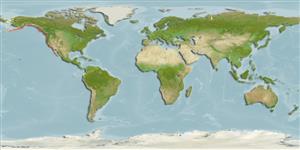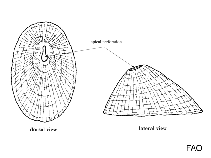Diodora aspera (Rathke, 1833)
Keyhole limpet| Native range | All suitable habitat | Point map | Year 2050 |

|
| This map was computer-generated and has not yet been reviewed. |
| Diodora aspera AquaMaps Data sources: GBIF OBIS |
Upload your photos
Google image | No image available for this species;
drawing shows typical species in Fissurellidae.
Google image | No image available for this species;
drawing shows typical species in Fissurellidae.
Classification / Names Common names | Synonyms | CoL | ITIS | WoRMS
Gastropoda | Lepetellida | Fissurellidae
Environment: milieu / climate zone / depth range / distribution range Ecology
Benthic; depth range 0 - 15 m (Ref. 865). Temperate
Distribution Countries | FAO areas | Ecosystems | Occurrences | Introductions
Eastern Pacific and the Arctic: from Alaska to Baja California. Subtropical to polar.
Length at first maturity / Size / Weight / Age
Maturity: Lm ? range ? - ? cm Max length : 7.5 cm TL male/unsexed; (Ref. 865); common length : 7.0 cm SHL male/unsexed; (Ref. 312)
Short description Morphology
Description: Color is usually gray-brown and white. Radiating ribs of shell are both light and dark. There is a small opening at the peak (Ref. 312).
It has a shell length of 7 cm long (Ref. 312). Occurs at low intertidal zones. Omnivorous; encrusting bryozoans are sometimes consumed in preference to algae. When under attack by a sea star, it will extend its mantle flap over its foot and shell so that the tube feet of the star fish cannot grasp it (Ref. 312).
Life cycle and mating behavior Maturity | Reproduction | Spawning | Eggs | Fecundity | Larvae
Members of the order Patellogastropoda are mostly gonochoric and broadcast spawners. Life cycle: Embryos develop into planktonic trocophore larvae and later into juvenile veligers before becoming fully grown adults.
Main reference
References | Coordinator | Collaborators
Gallivan, G. and J. Danforth. 1999. (Ref. 312)
IUCN Red List Status (Ref. 130435)
CITES status (Ref. 108899)
Not Evaluated
CMS (Ref. 116361)
Not Evaluated
Threat to humans
Human uses
| FishSource |
Tools
More information
Internet sources
BHL | BOLD Systems | CISTI | DiscoverLife | FAO(Publication : search) | Fishipedia | GenBank (genome, nucleotide) | GloBI | Gomexsi | Google Books | Google Scholar | Google | PubMed | Tree of Life | Wikipedia (Go, Search) | Zoological Record
Estimates based on models
Preferred temperature
(Ref. 115969): 6.3 - 15.7, mean 8.9 (based on 395 cells).
Price category
(Ref. 80766):
Unknown.



